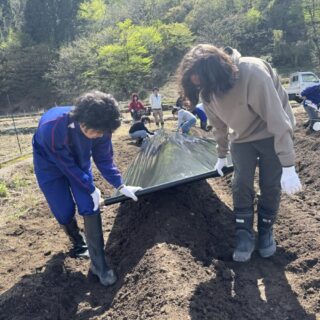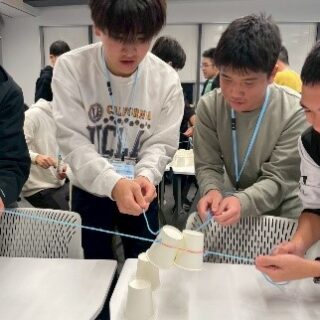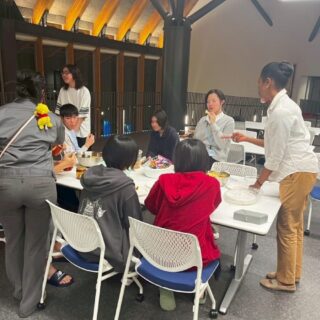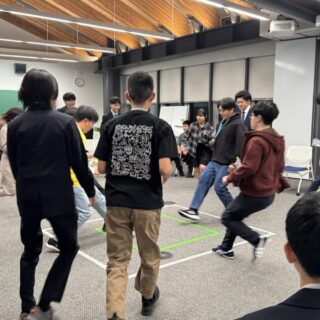Hakusanroku
白山麓キャンパス
 こんにちは。校長の鹿田 正昭です。
こんにちは。校長の鹿田 正昭です。
 2025年4月24日(木)、今回で3回目の参加となる、エンジニアリングデザインⅡ(2年生)「紅はるか」の苗植えをお手伝いしました。今回は金沢キャンパスで会議があったため、会議終了後に白山麓キャンパスに移動し、到着した頃にはすでに畝が完成し、植え付けが始まっていました。今年は西側から2列目を半分ほど植えました。今冬は雪が多かったため土がかなり湿っている感じでしたが、この方が作業を進めやすいと感じました。
2025年4月24日(木)、今回で3回目の参加となる、エンジニアリングデザインⅡ(2年生)「紅はるか」の苗植えをお手伝いしました。今回は金沢キャンパスで会議があったため、会議終了後に白山麓キャンパスに移動し、到着した頃にはすでに畝が完成し、植え付けが始まっていました。今年は西側から2列目を半分ほど植えました。今冬は雪が多かったため土がかなり湿っている感じでしたが、この方が作業を進めやすいと感じました。
苗植えは3回目となりましたが、慣れてきたとはいえやはり自分の植えた苗が収穫時にうまく育っているか気になります。一昨年は雨が多かったせいか、あまり大きな芋の収穫はできませんでした。昨年は天候も良く、適度な雨だったため大きな芋が育ちました。今年も昨年同様な出来具合を期待したいと思います。
2年生全員とエンジニアリングデザインⅡ担当の先生方、ラーニングメンターのアブワン兄妹も参加して午後4時前に苗付けを完了しました。そして電気柵の設置や獣害対策が施され、今年も昨年に引き続いての豊作を期待したいと思います。
本校では11月1日(土)、2日(日)にオープンキャンパスを開催します。これに合わせて恒例の焼き芋販売が「道の駅瀬女」で行われる予定です。お時間があれば、ぜひ「道の駅瀬女」まで足を伸ばしてみてください。
オープンキャンパス詳細はこちら
鹿田 正昭
Hello. I am Masaaki Shikada, ICT President.

On Thursday, April 24th, 2025, I helped plant Engineering Design II's "Kosen Beniharuka" seedlings for the third time. This time, I had a meeting at Kanazawa Campus, so I couldn’t travel to Hakusanroku Campus until after the meeting ended. By the time I arrived, the ridges had already been prepared and the planting had begun. This year I planted the second row from the west side. The soil was quite wet this winter due to the heavy snowfall, but I felt this made the work easier.
This is the third time I have planted seedlings, and although I am getting used to it, I still worry about whether the seedlings I planted will grow well. The year before last, the potatoes did not grow very large, probably because it rained a lot. Last year, good weather and moderate rainfall resulted in large potatoes. We expect this year's crop to be as good as last years.
All 2nd year students, Engineering Design II teachers, and Learning Mentors Domyson Abuan sensei and Sharmee Abuan sensei joined us to complete the seedling planting before 16:00. Then electric fences were installed and measures were taken to prevent damage from animals. We hope for another good harvest this year, following on from last year.
Our school will hold an open campus on Saturday, November 1st and Sunday, November 2nd. In conjunction with this event, the annual baked sweet potato sale will be held at the Sena Road Station. If you have time, please visit the Sena Road Station and try some potatoes!
Click here for more details about Open Campus
Masaaki Shikada
こんにちは、英語科目担当のポーリン・ベアードです。
あなたが持ち主でありながら、他の人の方がよく使うものは何でしょう?
そう、あなたの名前です!
授業の初日、学生たちに緊張感が漂っています。保護者の方も同じ思いで過ごされているのではないでしょうか。国際高専 では授業は英語で行われます。「ブリッジイングリッシュ・化学」の授業で「私の名前は…」というアイスブレイクを始めたところ、静まり返っていた教室は活気に溢れ、学生たちは大きな声と笑いに包まれました。
私の名前
「私の名前はトシムネです。私はトシ_、兄はトシ_、父はトシ_、祖父はトシ_。私の家族の男性は皆名前に『トシ』がつきます。」ある学生が名前についてのストーリーをシェアしてくれました。彼はストーリーを丁寧な英語で書き、そして嬉しそうに発表してくれたことにより、張りつめていた授業の雰囲気は一変しました。

 アクティブ・ラーニング
アクティブ・ラーニング
初めに、ペアを組んでアクティビティを始めました。学生たちは2人で1つのホワイトボードを共有しお互いの名前を書きだしました。ペアを組んで共に課題に取り組むことにより、お互い出会って間もない学生同士が打ち解けるきっかけになります。
学生たちに、あなたの名前を漢字で紹介してくださいと言うと、学生たちは戸惑いの表情を見せました。私にとって彼らの名前の漢字を読めませんでしたが、それでも漢字で名前を書いてもらいました。ペアで取り組むことで、学生たちの友情を築き、学生と教員が英語を学んだり教えたりする際に必要な体験を共有することに役立ちます。
次の課題は、自分の名前の意味や、その名前の由来について話すことでした。一人の学生はすぐに「知ってる、知ってる」と言って、ホワイトボードに丁寧な英語を書いて説明してくれました。名前の意味に関するジョークまでも話してくれました。また他の学生たちは、名前の由来を知らなかったので、私は
「お母さんに聞いてごらん」
と提案したところ、教室は笑いに包まれました。しかしすぐに、それが冗談ではなく本当だと分かったようでした。
「スマホを使って調べてごらん」、とアドバイスしました。
私は続いて「両親に電話かけてみたらどう?」と言いました。
すぐに何人かの学生は保護者に電話をかけ、授業の課題について伝えました。
電話で話しながら笑い出す学生たちもいました。ある学生は大きく笑いながら
「初めて知った」(この言葉は教員にとってまるで音楽のように聴き慣れた言葉です!)
と言いました。
彼は祖父が大好きだったテレビドラマの登場人物から同じ名前を名付けられたそうです。また他の学生たちは真剣に電話に耳を傾けながらも、顔には笑みが浮かんでいました。このように「ブリッジイングリッシュ・化学」初日の授業は楽しく幸せを感じられる時間となりました。
名前は架け橋
名前に関するアクティビティーを行ったのは今回が初めてではありません。初めて行ったのは、何年も前2000年代の初めに金沢工業大学で働いた頃です。その時に、私は学生たちと親しくなりたかったのですが、彼らの名前を発音することも覚えることも簡単にはできませんでした。そこで、名前についてのストーリーを話してもらうことで、覚えることに役立つと思ったのです。
私が教員として教え、住んだあらゆる場所で、多くの日本人とそして世界中の学生たちから自分たちの名前のストーリーを話してもらいました。そして、名前は単に個人を識別するためだけのものではないと学んだのです。人と人との絆を築き、そして自分自身と繋がり、祖先の中で自分を位置づけ、家庭と学校をつなぐ強力なツールでもあります。あなたも、出会った人や学生と親しくなりたいと思った時に、名前を覚えるだけにとどまらず、名前にまつわるストーリーを共有したり、また相手の名前にまつわるストーリーを尋ねたりしてみるのも良いでしょう。もしこの話が正しいと思い、そしてその国の文化にも適していると感じられるのなら…誰にでも、その人だけのストーリーがあります!
ポーリン・ベアード
Getting to Know You
Pauline Baird an English teacher at ICT.
What is the thing you own but others use the most? Yes, you guessed it correctly. It is your name!
Students in their first classes are often nervous. Some parents at home are nervous, too, for a good reason because classes at ICT are in English. However, when the “Bridge English Chemistry” class began with an ice-breaker activity called “My Name …,” the class went from silent to a buzz of activity, with loud voices speaking Japanese and English and laughter.
My Name
“My name is Toshimune. I am ‘Toshi_____,’ my brother is ‘Toshi ____’, my father is ‘Toshi _____,’ and my grandfather is ‘Toshi _____.’ All men in my family have the “Toshi” [in the name],” one student was delighted to share. He was so happy telling and writing the story in his most beautiful English. The classroom atmosphere was transformed because the students were engaged.


Active Learning
First, for a pair work activity, students were asked to share a whiteboard to write their names. Doing so allowed them to complete a task together. They become less shy with others they just met less than a few weeks.
At first, students were puzzled when asked to share their first names by writing them in Kanji. To be honest, I couldn’t read their names in Kanji, yet I asked students to write their names in Kanji. Pair activities help students build bonds of friendship and create a shared experience that students and teachers need while learning and teaching English.
The next task was to tell us what their names meant and how they got their names. One student readily blurted out,
“I know. I know,” and began writing his name story in beautiful English on the whiteboard. He even shared a joke about the meaning of his name.
Others were unsure how they got their names, so I suggested:
“Ask your mama.”
In response, the class erupted in laughter. The students soon learned that I was serious.
“Take your phones and do research,” advised.
I followed up by saying,
“How about calling your parents?”
Soon, a few students were on the phone with their parents, telling them they were in English class and about the assignment.
In some instances, those students went from giggles to full-blown laughter. For example, one student laughed loudly and exclaimed,
“I learned something.” (Those words are like music to a teacher’s ears!)
The student learned that his grandfather loved a character in a TV drama, which is how he was given that same name. Others listened carefully and made notes, but everyone smiled. Students were happy on the first day of Bridge English Chemistry class.
Bridging Divides
This isn’t the first time I have done activities like this. I developed this practice many years, in the early 2000s, while working at Kanazawa Institute of Technology. Back then, I desperately needed to connect with my students, but I could not easily say or remember their names. Thus, I decided to use the name story, which has helped me since then.
Many Japanese people and students around the world have shared their name stories in every place I have taught and lived. I have learned that a person’s name is not just for identification. It is a powerful tool for building bonds among people, connecting with ourselves, situating oneself in one’s ancestry, and bridging home and school. The next time you wish to connect with someone or a student, it may be helpful to not stop at just learning a name. You might consider sharing your name story or asking about a person’s name story, if it feels correct and culturally appropriate. Everybody has a story!
~ Dr. Pauline Baird
 白山麓キャンパスに積もっていた雪が溶け、小さな春の蕾の開花とともに、ここに集まった新入生たちも新たな門出の日を迎えました!
白山麓キャンパスに積もっていた雪が溶け、小さな春の蕾の開花とともに、ここに集まった新入生たちも新たな門出の日を迎えました!
こんにちは。ラーニングメンターのドミソン・アブワンです。私たちラーニングメンターは主に、白山麓キャンパスで学校生活を送る1・2年生と共に活動します。2025年4月、ここ白山麓キャンパスでは、新たな学び、成長、生活への旅路に立った新入生たちを歓迎しました。
平日の19:30~21:30まで、勉強や宿題、学習習慣を身につけるための「ラーニングセッション」を開催しています。もちろん、私たちラーニングメンターはそこで学習指導やサポートしたり、時には親身になって話をしたりします。
新入生がこの新しい環境に溶け込み、友達を作り、新学期をスタートできるよう、私たちは、楽しく充実した時間になるようなイベントを企画しました。
ラーニングセッション オリエンテーションからスタート
4月4日(金)、1・2年生がラーニングセッションのオリエンテーションに参加しました。私たちラーニングメンターは自己紹介をし、ラーニングセッションについて説明をしました。通常の授業と同じようにラーニングセッションもガイドラインに沿って、夜の時間を有効に使います。
その中で大切なことは、そう英語です!ラーニングセッションの時間は英語を使用し、3年生でのニュージーランド留学に備えて英語での生活に慣れることができるのです。
また、今年の新しいアクティビティーとして、学生の現在の英語レベルに合わせた記事を読み、質問に答えることで読解力を磨く「リーディング・ラボラトリー」を導入することとなりました。
その後は、1年生を対象にラーニングセッションで活用する場所について案内を行いました。アナウンスの掲示場所、学習資料の場所、静かな学習やグループワーク、ワークショップに使われる部屋などを簡単に紹介しました。
続いては、楽しみにしていた時間です。
ゲームや笑い合いを通して打ち解ける
オリエンテーションの部屋に戻り、チームビルディングゲームが始まりました!始めに「カップスタックチャレンジ」を行いました。これは少人数のグループに分かれ、紐付きの輪ゴム(1人につき1本)だけを使って、紙コップを積み上げて一番高いタワーを作り上げるゲームです。ハイペースで3回戦まで行われ、会場は笑いと歓声に包まれ、時にはハラハラする場面もあり、大いに盛り上がりました。優勝者にはもちろん賞品のお菓子が贈られました!
次は、趣味や興味のあることを質問する英語でのビンゴです。このゲームの目的は、できるだけ多くの学生と会話をし、ビンゴシートを完成させることです。最適なアイスブレイクとなり、全員が英語で会話や質問をし、お互いの共通点に気づくことができました。
最後に、学生たちはグループに分かれてSTEM(理科科目)に関する課題に取り組みました。これは、次回の化学の授業で行われる小テストに向けた課題です。化学実験室の安全性と器具の適切な使用法に関する問題を解きました。楽しい時間を過ごした後も、学生たちが協力し合い、集中力を発揮していた様子は素晴らしかったです。
グループへようこそ!
4月9日(水)、ラーニングセッションのグループ割りが発表され、学生たちは興奮に包まれました!ホグワーツ魔法魔術学校のような雰囲気ですが、魔法の呪文の代わりに宿題によってポイントが課されます。学生たちが自分のグループを見つけるたびに、(「やった!同じだ!」と)笑いと驚きの声が聞こえてきました。
一方で2年生はベテランとなり、宿題や課題をこなして、すぐに各グループのポイント獲得に取り組みました。学期末には、最も多くのポイントを獲得したグループに賞と賞品が贈られます。切磋琢磨の始まりです!
カラオケ、ボードゲーム、みんなの笑顔
4月11日(金)は新入生のために正式な歓迎会を開きました。2年生は頼もしく、ゲームの準備を手伝い、カラオケのスタートを切ってくれました!
学生たちは一人ずつマイクを手に取り、お気に入りのヒット曲を歌いました。ソロで歌う学生や、グループで歌う学生もいれば、一緒に踊ったり、会場は活気とたくさんの笑い声で溢れていました。
ボードゲーム、カードゲーム、積み上げゲームもあり、どのゲームも歓声が沸き起こりました。コンピューターゲームにも大勢の学生が集まり、あっという間にまるで以前から友達だったかのように絆を深めていました。
歓迎会では、私たち教員もそれぞれの学生と、新生活の様子や今学期で楽しみにしていることなどを、お菓子をつまみながら和やかな雰囲気の中で気軽に英語で会話をすることができました。
“スペシャル”への飛躍
ラーニングメンターが企画したこれらのアクティビティーが、新入生たちへの温かい歓迎と、白山麓キャンパスでの新生活の力強いスタートとなれれば嬉しく思います。新学期を始めるにあたり、これからラーニングセッションの時間にワークショップ、季節のイベント、楽しくグループチャレンジを開催していくことを楽しみにしています。
今後も続きをお伝えしていきますね。
ドミソン・アブワン

As the last patches of snow melted from the Hakusanroku campus grounds and tiny buds of spring began to bloom, something else started fresh, too—our newest batch of freshmen!
Hi, I’m Domyson Abuan, one of the Learning Mentors (LMs) here at ICT, and our team works closely with both 1st and 2nd year students. This April 2025, we opened our doors to welcome the incoming students who are just beginning their journey of learning, growing, and living here at the Hakusanroku campus.
Each weeknight from 7:30 P.M. to 9:30 P.M., we run Learning Sessions (LS)—a time dedicated to studying, doing homework, and building good study habits for students. And of course, us LMs are there to guide, support, and sometimes, just be a friendly face to talk to.
To help our 1st year students ease into this new environment, we planned some fun and meaningful events to help them meet their schoolmates, and get a head start on the semester.
Kicking Things Off: Learning Session Orientation
On Friday, April 4th, both 1st and 2nd year students gathered for our LS Orientation. We LMs introduced ourselves and gave a quick rundown of what the session is all about. Just like their morning classes, LS has a set of guidelines so everyone knows how to make the most of their evenings.
One important part? English time! Students are encouraged to use English during LS so they can get used to it in preparation for their life in New Zealand when they are 3rd year students.
We also introduced this year’s new activity: a Reading Laboratory where students read an article suited to their current level and answer a few questions to sharpen their reading comprehension.
Afterwards, the 1st year students were given a short tour around the LS spaces—like where to find the announcements, where to grab study materials, and which rooms are used for quiet study and group work.
Then, the real fun began.
Games, Giggles, and Getting to Know Each Other
Back in the orientation room, it was time for some team-building games! First up was the Cup Stack Challenge. Divided into small groups, students had to work together using only a rubber band with strings (one per teammate) to stack paper cups into the tallest tower. With three rounds of fast-paced building, the room was filled with laughter, cheering, and a few dramatic cup crashes. Winners, of course, got snack prizes!
Next was English Bingo, with questions about hobbies and personal interests. The goal? Talk to as many classmates as possible to complete your bingo sheet. It was a great icebreaker and got everyone chatting in English, asking questions, and realizing they already have things in common.
To wrap things up, students worked together in groups to complete their STEM (Science subject) worksheets—an actual study task to help them prep for an upcoming quiz in their Chemistry class. They answered questions on laboratory safety and proper use of apparatus. We were really proud of how well they collaborated and focused, even after all the fun.
Welcome to the House System!
On Wednesday, April 9th, excitement was in the air as the students were sorted into their Houses! Think Hogwarts vibes, but with homework points instead of magic spells. As each student discovered their house, you could hear laughter and surprise (“Yay! I'm with you!”) across the room.
Meanwhile, the 2nd years, now seasoned pros, jumped right into earning points for their houses by completing homework and doing tasks. At the end of semester, the house with the most points wins the House Cup and a special reward. Let the friendly competition begin!
Karaoke, Board Games, and Bright Smiles
To officially welcome the new students, we held a Welcome Party on Friday, April 11th. The 2nd years really stepped up—they helped set up games and even kicked off the karaoke session!
One by one, students took the mic and sang their favorite hits. Many sang solo, some in groups, and others danced along. The room buzzed with energy and lots of laughter.
There were board games, card games, and stacking challenges too—each bringing out bursts of cheers. A computer game even pulled a huge crowd, and before long, many were playing and bonding like old friends.
Throughout the party, us teachers made our rounds, casually chatting with students in English about how they were settling in and what they looked forward to the most this semester - the chats were made more fun of course by delicious snacks.
A Springboard into Something Special
We hope these activities gave our freshmen a warm welcome and a strong start to their life here at Hakusanroku campus. With a new semester ahead, we're excited for more workshops, holiday events, and fun group challenges during our Learning Sessions.
And yes—we’ll definitely keep you posted.
Domyson Abuan
 こんにちは。白山麓高専事務室の間加田 侑里です。白山麓キャンパスでは24名の新入生を迎え、学生たちは新たなキャンパスライフに慣れてきた様子です。さて、今回は2025年4月1日(火)の入学式後に開催された1・2年生合同の「アイスブレイク」について紹介します。
こんにちは。白山麓高専事務室の間加田 侑里です。白山麓キャンパスでは24名の新入生を迎え、学生たちは新たなキャンパスライフに慣れてきた様子です。さて、今回は2025年4月1日(火)の入学式後に開催された1・2年生合同の「アイスブレイク」について紹介します。
まず初めに、「Identity Crisis」というゲームが行われました。ラーニングメンターから、1・2年生それぞれの名前が書かれた紙が、学生一人ひとりに配られ、学生たちはその紙に書かれている人物を探し出すというミッションに挑戦しました。さらに、椅子の裏にも学生の名前が書かれている紙が貼ってあり、最後には「自分の名前が書かれた椅子を見つけて座る」という課題もありました。
ゲームが始まると、学生たちはお互いに自己紹介をしながら、紙に書かれた人物を探し始めました。自分の名前が書かれた紙を持っている相手を見つけるのには少し時間がかかっていましたが、相手が自分の名前を見つけた瞬間には大きな笑顔を見せ、その瞬間は大いに盛り上がりました。また、学生同士が声を掛け合ったり協力し合ったりしながら、自分の名前が書かれた椅子を探している姿も印象的でした。
-
Students introduced themselves to each other and checked whether the other person was holding the paper with their name on it.自己紹介し合い、相手が自分の名前が書かれた紙を持っているか確認
-
Checking names under the chairs. 椅子の裏の名前を確認
-
Found his name under a chair.椅子の裏に自分の名前を発見!
 次に、「In the Box」というゲームが行われました。これは、お互いの共通点や趣味を見つけることを目的としたものです。まず、学生たちは自分の趣味や出身地、好きな食べ物、得意なことなどを紙に書きました。その後、ラーニングメンターがその紙を回収し、内容を一つずつ読み上げました。学生たちは、読み上げられた内容と自分に共通点があった場合、中央の枠に向かって走り出しました。
次に、「In the Box」というゲームが行われました。これは、お互いの共通点や趣味を見つけることを目的としたものです。まず、学生たちは自分の趣味や出身地、好きな食べ物、得意なことなどを紙に書きました。その後、ラーニングメンターがその紙を回収し、内容を一つずつ読み上げました。学生たちは、読み上げられた内容と自分に共通点があった場合、中央の枠に向かって走り出しました。
枠は二重になっており、外側の枠に入ると1コイン、中央の枠に入ると2コインがもらえるというルールでした。学生たちが書いた内容は「本を読むのが好き」、「ペンギンが好き」、「国際高専が好き」など、さまざまな情報が読み上げられる中、「ノルウェー出身」や「インドネシア出身」といった内容が出ると、学生たちからは拍手がおこったり、和やかな雰囲気になりました。
最後に、コインの数が多かった3名の学生にはお菓子がプレゼントされました。
アイスブレイクを通して、学生たちはお互いのことを知るきっかけをつかむことができたようです。
@ictkanazawa 2025年4月1日(火)、白山麓キャンパス(1、2年生)でアイスブレイクが行われ、共通点を見つけるゲームが実施されました👀✨緑の枠に入ると2ポイント、白い枠に入ると1ポイント付与され、ポイントの多い3名にはお菓子がプレゼントされました🍫🍪 学生たちは、アイスブレイクを通して、お互いを知ることができたのではないでしょうか✨ #国際高専
♬ ABC - Jackson 5
-
Write down hobbies, hometowns, favorite foods, special skills on a piece of paper.紙に自分の趣味や出身地、好きな食べ物、得意なことなどを記入
-
Run to the center box!自分に共通点があった場合、中央の枠に向かって走り出しました!
-
Get in the box!枠の中に入ります!
-
Received a coin!コインゲット!
-
The three winters!コインが多かった3名の学生!
間加田 侑里
 Hello! This is Yuri Makada from the Hakusanroku office. At ICT, 24 new students have arrived and are beginning to settle into their new campus life. This time, I would like to write the icebreaker activities held on Tuesday, April 1st, 2025, after the entrance ceremony.
Hello! This is Yuri Makada from the Hakusanroku office. At ICT, 24 new students have arrived and are beginning to settle into their new campus life. This time, I would like to write the icebreaker activities held on Tuesday, April 1st, 2025, after the entrance ceremony.
The first activity was a game called "Identity Crisis." Learning mentors handed out slips of paper to each student, with the name of another 1st and 2nd year student written on it. The mission was to find the person whose name was written on the paper. In addition, pieces of paper with students' names were also hidden under the chairs. At the end of the game, students had to find the chair with their own name written underneath and sit on it.
As the game began, students introduced themselves to each other while searching for the person on their paper. It took some time to find one another, but once they found their name, they seemed really happy with big smiles and the atmosphere became lively and cheerful.
It was also memorable to see students calling out to one another and then working together to find the chair with their own name on it.
-
Students introduced themselves to each other and checked whether the other person was holding the paper with their name on it.自己紹介し合い、相手が自分の名前が書かれた紙を持っているか確認
-
Checking names under the chairs. 椅子の裏の名前を確認
-
Found his name under a chair.椅子の裏に自分の名前を発見!
Next, a game called “In the Box” was held. The purpose of this was to find commonalities and hobbies among each other. First, students wrote their hobbies, hometowns, favorite foods, specialties, etc. on a piece of paper. The Learning Mentors then collected the papers and read out the contents one by one. If the students found something they had in common with what was read, they ran toward the center of the room.
In the center of the room, there were two tape outlines in the shape of 2 boxes, with the rule that if they entered the outer box, they received one coin, and if they entered the inter box, they received two coins. The students wrote a variety of information, such as “I like reading books,” “I like penguins,” “I like ICT,” etc. When information such as “I'm from Norway” or “I'm from Indonesia” was shared, the students responded with applause, creating a warm and friendly atmosphere.
At the end of the session, the three students with the highest number of coins were presented with snacks!
Through the icebreakers, the students seemed to be able to get to know each other better.
@ictkanazawa 2025年4月1日(火)、白山麓キャンパス(1、2年生)でアイスブレイクが行われ、共通点を見つけるゲームが実施されました👀✨緑の枠に入ると2ポイント、白い枠に入ると1ポイント付与され、ポイントの多い3名にはお菓子がプレゼントされました🍫🍪 学生たちは、アイスブレイクを通して、お互いを知ることができたのではないでしょうか✨ #国際高専
♬ ABC - Jackson 5
-
Write down hobbies, hometowns, favorite foods, special skills on a piece of paper.紙に自分の趣味や出身地、好きな食べ物、得意なことなどを記入
-
Run to the center box!自分に共通点があった場合、中央の枠に向かって走り出しました!
-
Get in the box!枠の中に入ります!
-
Received a coin!コインゲット!
-
The three winters!コインが多かった3名の学生!
Yuri Makada
 こんにちは、財務部の泉屋 利吉です。
こんにちは、財務部の泉屋 利吉です。
2025年3月1日(土)19:00、まだ雪が多く残るこの東二口歴史民俗資料館には、続々と村の方々が集まる姿がありました。
この東二口文弥人形浄瑠璃は350余年も続く、国指定重要無形民俗文化財であり、京都からこの地にやってきた伝統文化です。350年もの間受け継がれてきたと聞くだけで、その大切さを感じますが、「でくの舞」を披露する演者や、その舞を鑑賞する人々も、「この“でくの舞”を見ないと一年が始まらない」と声を揃えて言っていたのが印象的でした。
冬の寒い農閑期の時期の一つの楽しみにとして、現代まで受け継がれてきたものですが、文楽とはまた異なり、文弥節と呼ばれる独特の語り口で物語が進んでいきます。
初めて聞く人は内容が良く分からないと思いますが、演目が始まる前に、紙芝居があり、演目の内容を丁寧に教えてくれます。私もこの紙芝居がなかったら正直ついていけなかったと思いました。
この東二口に伝わる文弥人形浄瑠璃ですが、近年継承する人たちも高齢化が進み、伝承が難しくなっています。今は十数名ででくの舞を披露していますが、おそらく裏方作業も含め、一人何役もこなしているのではないかと思います。
そのような中、国際高専の松下 臣仁教授が5年前からこの人形浄瑠璃の演者として参加し、毎年公演会に参加しています。その他金沢工業大学の職員や学生などもでくの舞の保存会へ参加し、ベテランの先輩方から、でくの舞の舞い方を習いつつ、東二口の伝統と文化を受け継ごうとしています。
「でくの舞」に使われる人形は、「かしら」「心棒」「肩板」「手」の4つのパーツから出来ており、一人で1体の人形を操ります。文楽では3人で1体の人形を操りますが、「でくの舞」で使われる人形はシンプルではありますが、扱うことが出来るまでには相当な修練が要求されます。また、人形と一体となって、3歩前進し2歩後退する舞い手の足運びが独特であり、床を足で叩きながら、リズミカルに舞を披露します。これが、舞踊的な感じを生み出し、「でくの舞」と呼ばれる所以となりました。まさに、人形を操るのではなく、逆に人形と一体となって舞い手が操られる感覚が要求されるとの事で、その奥深さを感じずにはいられません。
350余年もの間、人々から愛され続けてきた人形浄瑠璃が、この白山市に残っている事も感動的ですが、その伝統を受け継いでいく方々の努力や思いは計り知れないものがあると感じました。演目が披露された東二口歴史民俗資料館の舞台は、多くの人は入れませんが、昔ながらの雰囲気が残る場所であり、人形浄瑠璃を間近に見ることが出来ます。
松下教授のでくの舞を見ながら、ふと300年前の世界にタイムスリップしたような気分にさせられました。でくの舞の「泣き節」と呼ばれる文弥節とリズミカルに床を蹴る舞い手の足運びの音が今も頭に余韻として残っています。
-
Audience watching the performance up close演舞を間近に鑑賞する聴衆
-
Photo of Omihito sensei and ICT student国際高専の学生と一緒に写る松下教授
-
Omihito sensei becomes one with the doll人形と一体となる松下教授(左)
-
Higashi Futakuchi Local History Museum,白山市東二口歴史民俗資料館
-
Puppets dancing on the stage舞台を所狭しと人形が舞う
泉屋 利吉
 Hello, this is Rikichi Izumiya from Finance Division.
Hello, this is Rikichi Izumiya from Finance Division.
At 7:00 P.M., on Saturday, March 1st, 2025, people from the villages surrounding Higashi Futakuchi gathered at the Higashi Futakuchi Local History Museum, despite there still being a lot of snow on the ground.
This annual Higashi Futakuchi Bunya Ningyo Joruri performance has continued for more than 350 years and is a nationally designated Important Intangible Folk Cultural Property, a traditional culture that came to this area from Kyoto. Just hearing that it has been passed down for 350 years makes me appreciate its significance. What left a strong impression on me was that both the performers of the Deguno Mai and those who watched it all said in unison, "Every year cannot begin without seeing this Deguno Mai."
This tradition has been passed down to the present day as one of the high points of the cold, agricultural off-season in winter. Unlike Bunraku, however, the story unfolds in a unique narrative style called Bunya bushi.
For those seeing it for the first time, the story may be difficult to understand. However, before the performance begins, a kamishibai (picture-story show) is presented, carefully explaining the content of the performance. Honestly, I think I would have had a hard time keeping up without it.
This Bunya Ningyo Joruri, passed down in Higashi Futakuchi, is facing challenges in preservation as the people inheriting it are aging. Currently, a little over ten performers present the Deguno Mai, but I assume that, including backstage roles, each person is taking on multiple responsibilities.
Amid these challenges, Omihito Matsushita sensei from ICT has been participating as a performer in this Ningyo Joruri for the past five years, taking part in the annual performances. Additionally, faculty members and students from KIT have joined the Deguno Mai preservation society, learning the dance from experienced elder members while striving to inherit the traditions and culture of Higashi Futakuchi.
The puppets used in Dekunomai consist of four parts: the Kashira (head), Shinbo (central rod), Kataban (shoulder board) and Te (hands). Each puppet is operated by a single performer. Although the puppets used in Deguno Mai are relatively simple in structure, mastering their manipulation demands considerable training.
Additionally, the performers move in a distinctive manner, taking three steps forward and two steps back, while rhythmically striking the floor with their feet as they dance. This unique footwork creates a dance-like impression, which is why it came to be known as Deguno Mai. Rather than simply controlling the puppet, performers must become one with it—almost as if they are being guided by the puppet itself. This profound technique highlights the depth and artistry of the performance, leaving a lasting impression.
It is truly moving that this Ningyo Joruri, which has been cherished by people for over 350 years, still remains in Hakusan City. At the same time, I feel that the efforts and dedication of those who continue to uphold this tradition are beyond measure. The performance took place on the stage of the Higashi Futakuchi Local History Museum. While the space cannot accommodate a large audience, it retains the atmosphere of the past, allowing visitors to experience Ningyo Joruri up close.
Watching Omihito sensei perform Deguno Mai, I suddenly felt as if I had traveled back in time to the world of 300 years ago. The lingering echoes of the Bunya bushi style, known as the "Naki-bushi" (weeping melody), along with the rhythmic sound of the performers’ footwork striking the floor, still resonate in my mind.
-
Audience watching the performance up close演舞を間近に鑑賞する聴衆
-
Photo of Omihito sensei and ICT student国際高専の学生と一緒に写る松下教授
-
Omihito sensei becomes one with the doll人形と一体となる松下教授(左)
-
Higashi Futakuchi Local History Museum,白山市東二口歴史民俗資料館
-
Puppets dancing on the stage舞台を所狭しと人形が舞う
Rikichi Izumiya

























































